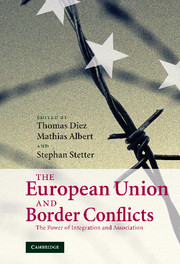Book contents
- Frontmatter
- Contents
- List of tables
- Notes on contributors
- Acknowledgements
- List of abbreviations
- Introduction
- 1 The transformative power of integration: conceptualising border conflicts
- 2 The influence of the EU towards conflict transformation on the island of Ireland
- 3 Catalysis, catachresis: the EU's impact on the Cyprus conflict
- 4 Transforming the Greek–Turkish conflicts: the EU and ‘what we make of it’!
- 5 Border issues in Europe's North
- 6 The EU and the Israel–Palestine conflict
- 7 The EU as a ‘force for good’ in border conflict cases?
- Conclusion
- References
- Index
5 - Border issues in Europe's North
Published online by Cambridge University Press: 22 September 2009
- Frontmatter
- Contents
- List of tables
- Notes on contributors
- Acknowledgements
- List of abbreviations
- Introduction
- 1 The transformative power of integration: conceptualising border conflicts
- 2 The influence of the EU towards conflict transformation on the island of Ireland
- 3 Catalysis, catachresis: the EU's impact on the Cyprus conflict
- 4 Transforming the Greek–Turkish conflicts: the EU and ‘what we make of it’!
- 5 Border issues in Europe's North
- 6 The EU and the Israel–Palestine conflict
- 7 The EU as a ‘force for good’ in border conflict cases?
- Conclusion
- References
- Index
Summary
Overview of the conflict
Towards shared space
This chapter covers Europe's North in a region-specific perspective, exploring the European Union's role as a ‘perpetuator’ of conflicts in a broader, regional context. In the first place, as the relevant issues of the post-Cold War period have been – almost without exception – dealt with in a fairly peaceful fashion, the proper term to be used might be disputes rather than conflicts. It is also worth noting that although the EU broadly covers the region, the intra-regional forces seem to have impacted on the various conflictual issues at least as forcefully as the EU.
In general, Europe's North has been quite quick in capitalising on the option of change that opened up with the end of the Cold War. Having been profoundly divided by the conflict between East and West with region-formation not even existing as an idea (with the exception of Nordic cooperation), the North has not merely caught up with the rest of Europe, it has, in fact, turned into one of the most regionalised parts of the continent. Borders, previously seen as lines of exclusion and defence, have changed in meaning with the emergence of a rich patchwork of various Euro-regions, trans-boundary arrangements, cross-border projects and contacts of twinning. Old divides and suspicions have to a large extent been replaced by building a new sense of regional community as exemplified by Baltic Sea cooperation, Barents Euro-Arctic cooperation and Arctic cooperation.
- Type
- Chapter
- Information
- The European Union and Border ConflictsThe Power of Integration and Association, pp. 129 - 172Publisher: Cambridge University PressPrint publication year: 2008
- 3
- Cited by



